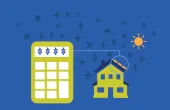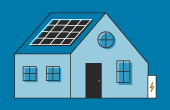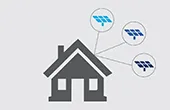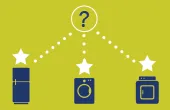In this week’s news roundup, we discuss an exciting new use for utility scale solar, and an important initiative by the Biden administration to help underserved communities gain access to solar power.
Continue readingThermodynamic solar panels: what are they and how do they work?
Typically, when you think about solar panels, you picture solar photovoltaics (PV): panels that are installed atop your roof or in an open space and convert sunlight into electricity. However, solar panels can also be thermal, meaning that they convert sunlight into heat as opposed to electricity. Thermodynamic solar panels are one type of thermal solar panel–also called a collector–that differ dramatically from traditional thermal panels; instead of requiring direct sunlight, thermodynamic solar panels can also generate power from heat in the air.
Continue readingComparing microinverters vs. inverters with power optimizers
Inverters are a key component of any solar panel system: while solar panels convert sunlight into electricity, inverters ensure that you can use the electricity they produce in your home or business.
Continue readingNet metering 3.0: what does it mean for you, and how can you help?
If you look at the best solar markets in the US, they all have one thing in common: a strong net metering policy. Net metering–or NEM–allows you to earn credits for any excess solar electricity you send to the grid when your solar panel system generates more than you need.
Over the next year, California will be releasing the third iteration of net metering, or NEM 3.0. And as of summer 2021, there’s still a lot for the state to decide on – we don’t know exactly how credit values will change, or what they’ll change to, but we do know that whatever happens will have large implications for the country’s leading solar market. We’ll continue to keep this article updated with the most recent news on NEM 3.0, and in the meantime, discuss some of the proposed changes to the state’s current net metering policy, along with timelines.
Continue readingHow are supply constraints impacting the solar industry?
While many COVID-19 pandemic restrictions are starting to be lifted across the United States, pandemic-related supply chain issues continue to be felt across many sectors, including the solar industry. In spring 2020, solar equipment manufacturers experienced significant delays due to workplace and travel restrictions. As the pandemic continued throughout 2020 and into 2021, consumer demand largely shifted away from services, such as dining and travel, towards goods, such as computers and televisions, leading to shortages for key manufacturing components. In this article, we’ll cover some of the supply constraints currently facing the solar industry, and how these constraints are impacting solar shoppers.
Continue readingSungage Financial zero fee loan review
Solar loans are a very popular way to pay for a new solar or solar plus storage system, since they are a great way to take advantage of the benefits of solar ownership–from tax incentives to increased home value–without requiring you to have the cash on hand to pay for the full system up front. What’s more, many solar-specific loans offer low, fixed interest rates and flexible payment terms, helping you to find the monthly payment that’s right for you. However, a low interest rate (or APR) comes with a caveat: a low APR often means a high cost to borrow money. That cost or fee to borrow money is passed on to your installer, or even built into the overall cost of the project, making a tradeoff between the lowest monthly payment (i.e., low APR) and the lowest project cost (i.e., lowest cost to borrow money).
Recently, Sungage Financial, one of the most popular solar loan providers on EnergySage, launched a zero fee solar loan to keep your solar project costs as low as possible. Here’s what that means for solar shoppers like you.
Continue readingSo your old solar panel system no longer fits your needs: what are your options?
Home solar systems have now been around for quite some time, reliably powering homes across the country with clean, renewable energy. If you were an early adopter, your system is likely getting up there in terms of age. Although solar panels last for 25 to 30 years on average, with an older system you might be encountering some defects, general wear and tear, or a drop in electricity production brought on by age. Whatever the reason, if your solar system is no longer producing the kind of energy you need, we’re here to show you some of your options.
Continue readingWhat is a solar charge controller? Do you need one?
If you’re considering installing an off-grid solar project with a battery attached, you’ll want to look into a solar charge controller for your system. Charge controllers act as a gateway to your battery, and ensure that you don’t overcharge and damage your energy storage system. In this piece, we’ll cover what a solar charge controller is, and how the two major types (PWM and MPPT) compare.
Continue readingSRECs in Pennsylvania: prices, projections, and program status
If you’re considering installing a solar panel system in Pennsylvania, one incentive to be aware of is solar renewable energy certificates (SRECs). Pennsylvania is one of the few states that offers this performance-based incentive to property owners generating solar electricity. Pennsylvanians who buy and install a solar panel system can earn hundreds of dollars each year by selling SRECs.
Continue readingBattery certifications and testing: what you need to know
Like other electronic products, home batteries go through rigorous testing before installation and use at your home or business. These tests are critical to determining the quality and performance of batteries under particular environmental stresses, as well as confirming they meet mandated government safety requirements. In this article, we’ll review the most common testing and certifications for home batteries on the market today.
Continue reading




